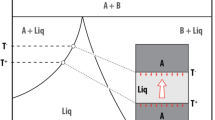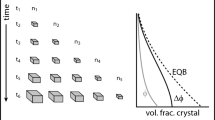Abstract
Xenolith assimilation has been simulated with experiments involving melting wax spheres into hot water and aqueous solutions and characterised by a theoretical analysis. Both the cases of neutrally buoyant stationary spheres and spheres sinking through the hot host fluid are examined. Melt generated on a sphere's surface flows (compositional convection) in two regimes; as a sheet over one hemisphere and then detaching as finger plumes from the other. Positional variations in the melting rate are dominantly controlled by differences in the melt layer thickness which influence the thermal gradient and heat flux across the layer. The theoretical model predicts melt layer thicknesses and the heat flux from the surrounding fluid. Calculated melting rates agree well with experimental measurements. Partial melting of non-eutectic compositions produces a layer of crystal-melt mush at the xenolith's surface. The theoretical analysis is extended to account for variation in rheological properties across the mush layer. When stoped into typical magmas, xenoliths of common continental crust lithologies are predicted to melt at rates in the order of 2 mm/hour. Thicknesses of the mobile mush layer around xenoliths are predicted to be typically a few centimetres. Relatively mafic lithologies can melt quicker than silicic compositions because, although they are typically more refractory, their lower melt viscosities result in thinner mush layers and so higher heat fluxes. Especially quick melting of water-saturated lithologies occurs as a consequence of both the reduction in melting temperatures and melt viscosities. Due to hot ambient conditions in the lower continental crust the assimilation of xenoliths into underplated basaltic magma can be very rapid. For granulites and mafic-granulites the predicted melting rates are up to 17 mm/hour. Fast rates of melting and efficient mixing of melt into the host magma indicate that assimilation of xenoliths will have a significant influence on the compositional and thermal evolution of magmas.
Similar content being viewed by others
Author information
Authors and Affiliations
Additional information
Received: 7 November 1996 / Accepted: 5 January 1998
Rights and permissions
About this article
Cite this article
McLeod, P., Sparks, R. The dynamics of xenolith assimilation. Contrib Mineral Petrol 132, 21–33 (1998). https://doi.org/10.1007/s004100050402
Issue Date:
DOI: https://doi.org/10.1007/s004100050402




